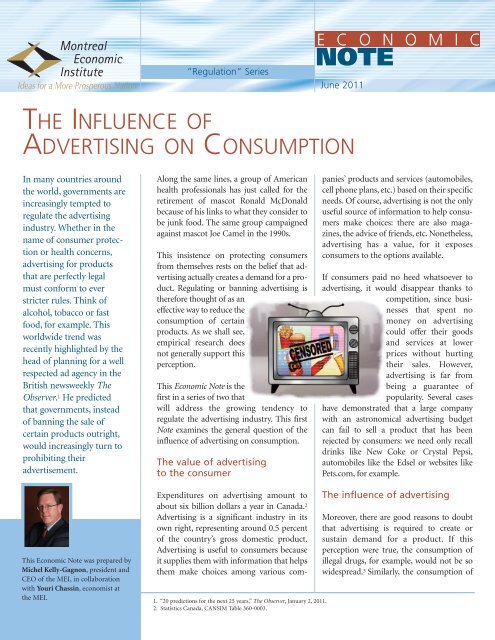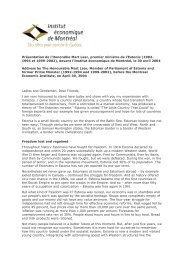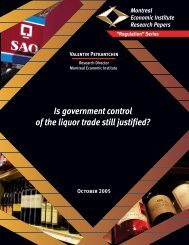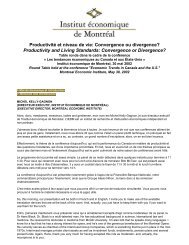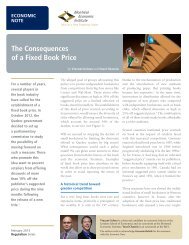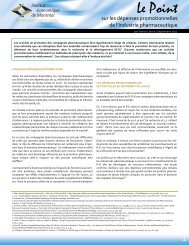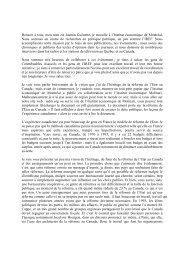The Influence of Advertising on Consumption - IEDM
The Influence of Advertising on Consumption - IEDM
The Influence of Advertising on Consumption - IEDM
You also want an ePaper? Increase the reach of your titles
YUMPU automatically turns print PDFs into web optimized ePapers that Google loves.
“Regulati<strong>on</strong>” SeriesE C O N O M I CNOTEJune 2011THE INFLUENCE OFADVERTISING ON CONSUMPTIONIn many countries aroundthe world, governments areincreasingly tempted toregulate the advertisingindustry. Whether in thename <str<strong>on</strong>g>of</str<strong>on</strong>g> c<strong>on</strong>sumer protec -ti<strong>on</strong> or health c<strong>on</strong>cerns,advertising for productsthat are perfectly legalmust c<strong>on</strong>form to everstricter rules. Think <str<strong>on</strong>g>of</str<strong>on</strong>g>alcohol, tobacco or fastfood, for example. Thisworldwide trend wasrecently highlighted by thehead <str<strong>on</strong>g>of</str<strong>on</strong>g> planning for a wellrespected ad agency in theBritish newsweekly <str<strong>on</strong>g>The</str<strong>on</strong>g>Observer. 1 He predictedthat governments, instead<str<strong>on</strong>g>of</str<strong>on</strong>g> banning the sale <str<strong>on</strong>g>of</str<strong>on</strong>g>certain products outright,would increasingly turn toprohibiting theiradvertisement.Al<strong>on</strong>g the same lines, a group <str<strong>on</strong>g>of</str<strong>on</strong>g> Americanhealth pr<str<strong>on</strong>g>of</str<strong>on</strong>g>essi<strong>on</strong>als has just called for theretirement <str<strong>on</strong>g>of</str<strong>on</strong>g> mascot R<strong>on</strong>ald McD<strong>on</strong>aldbecause <str<strong>on</strong>g>of</str<strong>on</strong>g> his links to what they c<strong>on</strong>sider tobe junk food. <str<strong>on</strong>g>The</str<strong>on</strong>g> same group campaignedagainst mascot Joe Camel in the 1990s.This insistence <strong>on</strong> protecting c<strong>on</strong>sumersfrom themselves rests <strong>on</strong> the belief that ad -vertising actually creates a demand for a pro -duct. Regulating or banning advertising istherefore thought <str<strong>on</strong>g>of</str<strong>on</strong>g> as aneffective way to reduce thec<strong>on</strong>sumpti<strong>on</strong> <str<strong>on</strong>g>of</str<strong>on</strong>g> cer tainproducts. As we shall see,empirical research doesnot generally support thispercepti<strong>on</strong>.This Ec<strong>on</strong>omic Note is thefirst in a series <str<strong>on</strong>g>of</str<strong>on</strong>g> two thatwill address the growing tendency toregulate the advertising industry. This firstNote examines the general questi<strong>on</strong> <str<strong>on</strong>g>of</str<strong>on</strong>g> theinfluence <str<strong>on</strong>g>of</str<strong>on</strong>g> advertising <strong>on</strong> c<strong>on</strong>sumpti<strong>on</strong>.<str<strong>on</strong>g>The</str<strong>on</strong>g> value <str<strong>on</strong>g>of</str<strong>on</strong>g> advertisingto the c<strong>on</strong>sumerpanies’ products and services (automobiles,cell ph<strong>on</strong>e plans, etc.) based <strong>on</strong> their specificneeds. Of course, advertising is not the <strong>on</strong>lyuseful source <str<strong>on</strong>g>of</str<strong>on</strong>g> informati<strong>on</strong> to help c<strong>on</strong>su -mers make choices: there are also maga -zines, the advice <str<strong>on</strong>g>of</str<strong>on</strong>g> friends, etc. N<strong>on</strong>etheless,advertising has a value, for it exposesc<strong>on</strong>sumers to the opti<strong>on</strong>s available.If c<strong>on</strong>sumers paid no heed whatsoever toad ver tising, it would di sappear thanks tocom petiti<strong>on</strong>, since busi -nesses that spent nom<strong>on</strong>ey <strong>on</strong> advertisingcould <str<strong>on</strong>g>of</str<strong>on</strong>g>fer their goodsand services at lowerprices without hurtingtheir sales. However,advertising is far frombeing a gua rantee <str<strong>on</strong>g>of</str<strong>on</strong>g>popularity. Several caseshave dem<strong>on</strong>strated that a large companywith an astr<strong>on</strong>omical advertising budgetcan fail to sell a product that has beenrejected by c<strong>on</strong>sumers: we need <strong>on</strong>ly recalldrinks like New Coke or Crystal Pepsi,automobiles like the Edsel or websites likePets.com, for example.This Ec<strong>on</strong>omic Note was prepared byMichel Kelly-Gagn<strong>on</strong>, president andCEO <str<strong>on</strong>g>of</str<strong>on</strong>g> the MEI, in collaborati<strong>on</strong>with Youri Chassin, ec<strong>on</strong>omist atthe MEI.Expenditures <strong>on</strong> advertising amount toabout six billi<strong>on</strong> dollars a year in Canada. 2<str<strong>on</strong>g>Advertising</str<strong>on</strong>g> is a significant industry in itsown right, representing around 0.5 percent<str<strong>on</strong>g>of</str<strong>on</strong>g> the country’s gross domestic product.<str<strong>on</strong>g>Advertising</str<strong>on</strong>g> is useful to c<strong>on</strong>sumers becauseit supplies them with informati<strong>on</strong> that helpsthem make choices am<strong>on</strong>g various com -1. “20 predicti<strong>on</strong>s for the next 25 years,” <str<strong>on</strong>g>The</str<strong>on</strong>g> Observer, January 2, 2011.2. Statistics Canada, CANSIM Table 360-0003.<str<strong>on</strong>g>The</str<strong>on</strong>g> influence <str<strong>on</strong>g>of</str<strong>on</strong>g> advertisingMoreover, there are good reas<strong>on</strong>s to doubtthat advertising is required to create orsustain demand for a product. If thispercepti<strong>on</strong> were true, the c<strong>on</strong>sumpti<strong>on</strong> <str<strong>on</strong>g>of</str<strong>on</strong>g>illegal drugs, for example, would not be sowidespread. 3 Similarly, the c<strong>on</strong>sumpti<strong>on</strong> <str<strong>on</strong>g>of</str<strong>on</strong>g>
ECONOMIC NOTEalcohol did not decrease substantially during AmericanProhibiti<strong>on</strong> (1920-1933). 4 Two categories <str<strong>on</strong>g>of</str<strong>on</strong>g> products have beenspecifically analyzed by researchers: alcohol and tobacco. <str<strong>on</strong>g>The</str<strong>on</strong>g>secases show that the impact <str<strong>on</strong>g>of</str<strong>on</strong>g> advertising <strong>on</strong> c<strong>on</strong>sumpti<strong>on</strong> isnegligible, or at least very minor compared to other social andcultural factors. Studies have highlighted the importance <str<strong>on</strong>g>of</str<strong>on</strong>g> theopini<strong>on</strong>s <str<strong>on</strong>g>of</str<strong>on</strong>g> <strong>on</strong>e’s family and peers in influencing <strong>on</strong>e’sc<strong>on</strong>sumpti<strong>on</strong> choices. 5AlcoholIndeed, in the alcohol market for example, empirical studies 6have c<strong>on</strong>cluded that advertising does notinfluence total c<strong>on</strong>sumpti<strong>on</strong>, by analyzingexperiments undertaken in the United States,Canada, France, the United Kingdom, theNether lands and Sweden. For instance, thelegalizati<strong>on</strong> <str<strong>on</strong>g>of</str<strong>on</strong>g> alcohol-related advertising inthe Canadian province <str<strong>on</strong>g>of</str<strong>on</strong>g> Saskatchewan in1983 did not lead to increased c<strong>on</strong>sumpti<strong>on</strong>.In those cases in which c<strong>on</strong>sumpti<strong>on</strong> seemsto increase in step with advertising, the truecause could in fact be the opposite <str<strong>on</strong>g>of</str<strong>on</strong>g> what it is thought to be. Ashighlighted in an article published by the World HealthOrganizati<strong>on</strong>, 7 when a market study shows a rising trend in thepopularity <str<strong>on</strong>g>of</str<strong>on</strong>g> a product, many businesses try “to get in <strong>on</strong> thepromising new bandwag<strong>on</strong>.” <str<strong>on</strong>g>The</str<strong>on</strong>g>y advertise more when theythink that c<strong>on</strong>sumpti<strong>on</strong> <str<strong>on</strong>g>of</str<strong>on</strong>g> a product is growing in order toobtain the largest possible share <str<strong>on</strong>g>of</str<strong>on</strong>g> the growing market. In otherwords, the volume <str<strong>on</strong>g>of</str<strong>on</strong>g> advertising could very well grow inreacti<strong>on</strong> to the increase in demand, and not the other wayaround.C<strong>on</strong>versely, if advertising increased c<strong>on</strong>sumpti<strong>on</strong>, forbidding itshould make the product less popular. This is not, however, whathas been observed in practice in the case <str<strong>on</strong>g>of</str<strong>on</strong>g> alcohol. Forexample, the banning <str<strong>on</strong>g>of</str<strong>on</strong>g> beer ads in 1974 in Manitoba did notdiminish c<strong>on</strong>sumpti<strong>on</strong> in that Canadian province as comparedwith c<strong>on</strong>sumpti<strong>on</strong> in the province <str<strong>on</strong>g>of</str<strong>on</strong>g> Alberta, where advertisingremained legal. 8Tobacco<str<strong>on</strong>g>Advertising</str<strong>on</strong>g> is useful toc<strong>on</strong>sumers because it suppliesthem with informati<strong>on</strong> thathelps them make choices am<strong>on</strong>gvarious companies’ productsand services based <strong>on</strong> theirspecific needs.<str<strong>on</strong>g>The</str<strong>on</strong>g> case <str<strong>on</strong>g>of</str<strong>on</strong>g> tobacco has also been extensively studied. For thepast 60 years, some 50 articles have been published <strong>on</strong> thesubject <str<strong>on</strong>g>of</str<strong>on</strong>g> the impact <str<strong>on</strong>g>of</str<strong>on</strong>g> the total or partial ban <str<strong>on</strong>g>of</str<strong>on</strong>g> cigaretterelatedadvertising in various countries. Researchers havepublished an unprecedented analysis integrating the results <str<strong>on</strong>g>of</str<strong>on</strong>g>27 studies featuring data from some 40countries. 9 <str<strong>on</strong>g>The</str<strong>on</strong>g>ir results indicate that thebanning <str<strong>on</strong>g>of</str<strong>on</strong>g> cigarette-related advertising,whether total or partial, has no significantimpact <strong>on</strong> the c<strong>on</strong>sumpti<strong>on</strong> <str<strong>on</strong>g>of</str<strong>on</strong>g> this product. 10<str<strong>on</strong>g>The</str<strong>on</strong>g> proporti<strong>on</strong> <str<strong>on</strong>g>of</str<strong>on</strong>g> smokers has been fallingfairly steadily since the mid-1960s. 11 This trendis due to several factors, including healthpreoccupati<strong>on</strong>s and a host <str<strong>on</strong>g>of</str<strong>on</strong>g> public policieslike tobacco taxes, the banning <str<strong>on</strong>g>of</str<strong>on</strong>g> smoking invarious places, the “denormalizati<strong>on</strong>” 12 <str<strong>on</strong>g>of</str<strong>on</strong>g> smokers, etc. <str<strong>on</strong>g>The</str<strong>on</strong>g>limits imposed <strong>on</strong> advertizing played a negligible to n<strong>on</strong>existentrole. Although there are certain public health studies that makea link between tobacco advertizing and youth c<strong>on</strong>sumpti<strong>on</strong>, anarticle by a Nobel laureate in ec<strong>on</strong>omics c<strong>on</strong>cluded that they d<strong>on</strong>ot respect the criteria required to establish a cause and effectrelati<strong>on</strong>ship. 13<str<strong>on</strong>g>The</str<strong>on</strong>g> regulati<strong>on</strong> <str<strong>on</strong>g>of</str<strong>on</strong>g> tobacco advertising has c<strong>on</strong>tinued apace, withfour countries banning the display <str<strong>on</strong>g>of</str<strong>on</strong>g> tobacco products: Canada,Iceland, Ireland and Thailand. Here again, the facts dem<strong>on</strong>stratethat this display ban has not affected c<strong>on</strong>sumpti<strong>on</strong> habits andc<strong>on</strong>stitutes a “highly ineffec tive” policy. 14M<strong>on</strong>treal Ecomomic Institute3. Filip Palda, “Publicité et commandites” in Pierre Lemieux and Jean-Luc Migué, Évaluati<strong>on</strong> éc<strong>on</strong>omique de l’Étude d’impact sur le projet de loi proposé par le Ministre de la Santé et desServices sociaux du Québec, May 1998, p. 78.4. Angela K. Dills and Jeffrey A. Mir<strong>on</strong>, “Alcohol Prohibiti<strong>on</strong> and Cirrhosis,” American Law and Ec<strong>on</strong>omics Review, Vol. 6 (2004), No. 2, p. 315.5. See: Marc G. Weinberger, Harlan E. Spotts and Ereni Markos, “Joe Camel: Post-mortem <str<strong>on</strong>g>of</str<strong>on</strong>g> a Brand Spokespers<strong>on</strong>,” Internati<strong>on</strong>al Journal <str<strong>on</strong>g>of</str<strong>on</strong>g> <str<strong>on</strong>g>Advertising</str<strong>on</strong>g>, Vol. 29 (2010), No. 3, p. 406.6. Tim Ambler, “Can Alcohol Misuse Be Reduced by Banning <str<strong>on</strong>g>Advertising</str<strong>on</strong>g>?” Internati<strong>on</strong>al Journal <str<strong>on</strong>g>of</str<strong>on</strong>g> <str<strong>on</strong>g>Advertising</str<strong>on</strong>g>, Vol. 15 (1996), No. 2, pp. 167-174.7. See: Juha Partanen and Marjatta M<strong>on</strong>t<strong>on</strong>en, “Alcohol and the Mass Media,” EURO Reports and Studies, Vol. 108 (1988), p. 7.8. Tim Ambler, op. cit., footnote 6, p. 170.9. Michael L. Capella, Charles R. Taylor and Cynthia Webster, “<str<strong>on</strong>g>The</str<strong>on</strong>g> Effect <str<strong>on</strong>g>of</str<strong>on</strong>g> Cigarette <str<strong>on</strong>g>Advertising</str<strong>on</strong>g> Bans <strong>on</strong> C<strong>on</strong>sumpti<strong>on</strong>,” Journal <str<strong>on</strong>g>of</str<strong>on</strong>g> <str<strong>on</strong>g>Advertising</str<strong>on</strong>g>, Vol. 37 (2008),No. 2, pp. 7-18 (c<strong>on</strong>fidence interval: 95%).10. Id., p. 14.11. Jessica L. Reid and David Hamm<strong>on</strong>d, Tobacco Use in Canada: Patterns and Trends: 2009 Editi<strong>on</strong>, Propel Centre for Populati<strong>on</strong> Health Impact (University <str<strong>on</strong>g>of</str<strong>on</strong>g> Waterloo), p. 14.12. <str<strong>on</strong>g>The</str<strong>on</strong>g> term “denormalizati<strong>on</strong>” is used to describe efforts aimed at making the c<strong>on</strong>sumpti<strong>on</strong> <str<strong>on</strong>g>of</str<strong>on</strong>g> tobacco less socially acceptable. See Health Canada, http://www.hc-sc.gc.ca/hcps/pubs/tobac-tabac/ns-sn/appendixc-annexec-eng.php.13. James J. Heckman, Fredrick Flyer, and Colleen Loughlin, “An Assessment <str<strong>on</strong>g>of</str<strong>on</strong>g> Causal Inference in Smoking Initiati<strong>on</strong> Research and a Framework for Future Research,” Ec<strong>on</strong>omicInquiry, Vol. 46 (2008), No. 1, pp. 42 and 43.14. Patrick Basham and John Luik, “Tobacco Display Bans: A Global Failure,” Ec<strong>on</strong>omic Affairs, Vol. 31 (2011), No. 1, p. 102.2THE INFLUENCE OF ADVERTISING ON CONSUMPTION
<str<strong>on</strong>g>Advertising</str<strong>on</strong>g> and product life cycleWhy do businesses spend so much <strong>on</strong> advertising if it does notincrease c<strong>on</strong>sumpti<strong>on</strong>? Quite simply to capture the largestpossible market share as compared to their competitors.This noti<strong>on</strong> fits well with what marketing specialists call the“product life cycle theory.” This theory stipulates that allproducts go through four stages: 1) intro -duc ti<strong>on</strong>, 2) growth, 3) maturity, and 4)decline. During the first stage, advertisingcreates and develops a new market. Think,for example, <str<strong>on</strong>g>of</str<strong>on</strong>g> fax machines or morerecently <str<strong>on</strong>g>of</str<strong>on</strong>g> tablet computers. However,during subsequent stages, advertisingc<strong>on</strong>centrates <strong>on</strong> brands, each companytrying to secure the largest possible market share that is firstgrowing, then stable and finally declining.<str<strong>on</strong>g>The</str<strong>on</strong>g> impact <str<strong>on</strong>g>of</str<strong>on</strong>g> advertising <strong>on</strong>c<strong>on</strong>sumpti<strong>on</strong> is negligible, or atleast very minor compared toother social and cultural factors.first, for products that are in the first stage <str<strong>on</strong>g>of</str<strong>on</strong>g> their life cycles, aswe saw above, and sec<strong>on</strong>d, for generic advertising sometimescarried out by producers’ associati<strong>on</strong>s (for example, for dairyproducts).However, it is helpful to specify what exactly is meant by a“market.” Indeed, researchers 16 have enumerated the following“levels” in a market:• the brand (for example Philadelphia creamcheese), which applies to a particularcompany’s product;• the sub-sector (cream cheese), which includesseveral brands in direct competiti<strong>on</strong>;• the sector (cheese), which includes several sub-sectors whoseproducts are close enough substitutes for <strong>on</strong>e another;A product like the cigarette, which has existed for centuries, hasarrived at the stage <str<strong>on</strong>g>of</str<strong>on</strong>g> decline in which advertising <strong>on</strong>ly has animpact <strong>on</strong> the market shares <str<strong>on</strong>g>of</str<strong>on</strong>g> different brands.Brands – well known and instantly recognizable names attachedto certain products – are a fundamental comp<strong>on</strong>ent <str<strong>on</strong>g>of</str<strong>on</strong>g>advertising. <str<strong>on</strong>g>The</str<strong>on</strong>g>y <str<strong>on</strong>g>of</str<strong>on</strong>g>ten borrow the name <str<strong>on</strong>g>of</str<strong>on</strong>g> the business itself,like “Ford” or “Dell.” Sometimes, they come to represent the type<str<strong>on</strong>g>of</str<strong>on</strong>g> product to which they are attached in an almost genericmanner, like “Tylenol” (from Johns<strong>on</strong> & Johns<strong>on</strong>) or “Kleenex”(from Kimberly-Clark). In a certain sense, these brands becomean integral part <str<strong>on</strong>g>of</str<strong>on</strong>g> popular culture. From a commercial point <str<strong>on</strong>g>of</str<strong>on</strong>g>view, brands are also a way for businesses to publicize the quality<str<strong>on</strong>g>of</str<strong>on</strong>g> their product. A brand allows a company to distinguish itsproduct from others 15 <strong>on</strong>ce it enters the sec<strong>on</strong>d and subsequentstages <str<strong>on</strong>g>of</str<strong>on</strong>g> its life cycle, thus helping to establish c<strong>on</strong>sumer loyalty.<str<strong>on</strong>g>Advertising</str<strong>on</strong>g> and market sizeAs we have just seen, the purpose <str<strong>on</strong>g>of</str<strong>on</strong>g> advertising is generally toincrease a brand’s market share rather than to develop themarket for all brands. This intent is easily observed when we seethe quantity <str<strong>on</strong>g>of</str<strong>on</strong>g> advertising that aims to attack (more or lessdirectly) rival brands. <str<strong>on</strong>g>The</str<strong>on</strong>g>re are rare excepti<strong>on</strong>s to this principle:• the category (dairy products), which includes sectors closeenough to <strong>on</strong>e another that c<strong>on</strong>sumers would be prepared tomake substituti<strong>on</strong>s, but not as easily as in the case <str<strong>on</strong>g>of</str<strong>on</strong>g> sectors;and• the super-category (food), made up <str<strong>on</strong>g>of</str<strong>on</strong>g> linked categories,which has little risk <str<strong>on</strong>g>of</str<strong>on</strong>g> being substituted for another supercategory<str<strong>on</strong>g>of</str<strong>on</strong>g> products.<str<strong>on</strong>g>Advertising</str<strong>on</strong>g> is not c<strong>on</strong>cerned with transportati<strong>on</strong> (a supercategory),with road vehicles (a category) with automobiles (asector) or even with four-wheel-drive automobiles (a subsector)in general. Auto makers and dealers advertise theirparticular brands. This advertising can have the effect <str<strong>on</strong>g>of</str<strong>on</strong>g>growing the size <str<strong>on</strong>g>of</str<strong>on</strong>g> the sub-sector, but it is rare for the effect tobe felt up to the sector or category levels. 17 This hierarchy is notuniform from <strong>on</strong>e study to another, but the important thing tounderstand is that advertising almost always c<strong>on</strong>cerns brands,and that as so<strong>on</strong> as we examine a higher “level” in the market, itvery rapidly loses its impact <strong>on</strong> c<strong>on</strong>sumpti<strong>on</strong>.According to a study that examined 156 cases <str<strong>on</strong>g>of</str<strong>on</strong>g> advertisingcampaigns that had achieved a high level <str<strong>on</strong>g>of</str<strong>on</strong>g> success in theUnited Kingdom, 18 this c<strong>on</strong>clusi<strong>on</strong> applies to most products.15. See: Richard Posner, “<str<strong>on</strong>g>Advertising</str<strong>on</strong>g> and Product Differentiati<strong>on</strong>” in John S. Wright and John E. Mertes (dir.), <str<strong>on</strong>g>Advertising</str<strong>on</strong>g>’s Role in Society, West Publishing Co., 1974, pp. 44-46.16. Tim Ambler, Sim<strong>on</strong> Broadbent and Paul Feldwick, “Does <str<strong>on</strong>g>Advertising</str<strong>on</strong>g> Affect Market Size?” Internati<strong>on</strong>al Journal <str<strong>on</strong>g>of</str<strong>on</strong>g> <str<strong>on</strong>g>Advertising</str<strong>on</strong>g>, Vol. 17 (1998), No. 3, p. 271.17. Michael L. Capella, Charles R. Taylor and Cynthia Webster, op. cit., footnote 9, p. 8.18. Tim Ambler, Sim<strong>on</strong> Broadbent and Paul Feldwick, op. cit., footnote 16, pp. 284-293.THE INFLUENCE OF ADVERTISING ON CONSUMPTION3M<strong>on</strong>treal Ecomomic Institute
ECONOMIC NOTEFor example, an advertising campaign for achewy bar (Quaker Harvest Chewy Bar) led to anincrease in the c<strong>on</strong>sumpti<strong>on</strong> <str<strong>on</strong>g>of</str<strong>on</strong>g> chewy bars, butdid not increase c<strong>on</strong>sumpti<strong>on</strong> in the chocolatesector. Similarly, a campaign for cannedmeatballs (Campbell’s) increased the size <str<strong>on</strong>g>of</str<strong>on</strong>g> themarket for canned meatballs,but not for canned food orprocessed meat in general.Alcohol and tobacco beingcategories <str<strong>on</strong>g>of</str<strong>on</strong>g> products (a higherlevel in the market “hierarchy”),it is normal to find, as we have,that the advertising <str<strong>on</strong>g>of</str<strong>on</strong>g> brandsdoes not increase the size <str<strong>on</strong>g>of</str<strong>on</strong>g> themarket. One brand’s advertisingin a certain sense cancels outanother brand’s advertising. 19At the end <str<strong>on</strong>g>of</str<strong>on</strong>g> the day, anextensive review <str<strong>on</strong>g>of</str<strong>on</strong>g> the relevantscientific literature shows that the totalc<strong>on</strong>sumpti<strong>on</strong> <str<strong>on</strong>g>of</str<strong>on</strong>g> such “unde sirable” productscannot be reduced by limiting or banning theiradvertisement since c<strong>on</strong> sumers do not simplyallow their choices to be dictated by ads.C<strong>on</strong>clusi<strong>on</strong>An extensive review <str<strong>on</strong>g>of</str<strong>on</strong>g> therelevant scientific literatureshows that the totalc<strong>on</strong>sumpti<strong>on</strong> <str<strong>on</strong>g>of</str<strong>on</strong>g>“undesirable” productscannot be reduced bylimiting or banning theiradvertisement sincec<strong>on</strong>sumers do not simplyallow their choices to bedictated by ads.<str<strong>on</strong>g>Advertising</str<strong>on</strong>g> informs people about the choicesavailable to them, or about the charac te ristics <str<strong>on</strong>g>of</str<strong>on</strong>g>certain products. But when all is said and d<strong>on</strong>e,the choice remains the c<strong>on</strong>sumer’s. What acompany hopes to do when itadvertises a product is promotewhat it can do better than itscompetitors and establish thebest possible brand image. In thisgame, what <strong>on</strong>e gains, anotherloses, and total c<strong>on</strong>sumpti<strong>on</strong> isnot affected in the vast majority<str<strong>on</strong>g>of</str<strong>on</strong>g> cases.<str<strong>on</strong>g>Advertising</str<strong>on</strong>g> is also a serviceindustry that relies <strong>on</strong> creativepr<str<strong>on</strong>g>of</str<strong>on</strong>g>essi<strong>on</strong>als and adds value toec<strong>on</strong>omic activity. Public policiesaiming to limit or ban theadvertisement <str<strong>on</strong>g>of</str<strong>on</strong>g> certain products harm thisindustry, and do so in vain. Indeed, empiricalresearch shows that regulating it in the hope <str<strong>on</strong>g>of</str<strong>on</strong>g>discouraging certain c<strong>on</strong>sumpti<strong>on</strong> habits isineffective. As is very <str<strong>on</strong>g>of</str<strong>on</strong>g>ten the case, between theintenti<strong>on</strong>s <str<strong>on</strong>g>of</str<strong>on</strong>g> these public policies and theiractual results, there is an enormous gulf intowhich are dumped the c<strong>on</strong>cepts <str<strong>on</strong>g>of</str<strong>on</strong>g> freedom <str<strong>on</strong>g>of</str<strong>on</strong>g>choice and individual resp<strong>on</strong>sibility, never to beheard from again over the course <str<strong>on</strong>g>of</str<strong>on</strong>g> the debate.1010, Sherbrooke Street W., Suite 930M<strong>on</strong>treal (Quebec) H3A 2R7, CanadaTeleph<strong>on</strong>e (514) 273-0969Fax (514) 273-2581Web site www.iedm.org<str<strong>on</strong>g>The</str<strong>on</strong>g> M<strong>on</strong>treal Ec<strong>on</strong>omic Institute is anindependent, n<strong>on</strong>-partisan, not-for-pr<str<strong>on</strong>g>of</str<strong>on</strong>g>itresearch and educati<strong>on</strong>al organizati<strong>on</strong>.Through its publicati<strong>on</strong>s, mediaappearances and c<strong>on</strong>ferences, the MEIstimulates debate <strong>on</strong> public policies inQuebec and across Canada by proposingwealth-creating reforms based <strong>on</strong> marketmechanisms. It does not accept anygovernment funding.<str<strong>on</strong>g>The</str<strong>on</strong>g> opini<strong>on</strong>s expressed in this study do notnecessarily represent those <str<strong>on</strong>g>of</str<strong>on</strong>g> the M<strong>on</strong>trealEc<strong>on</strong>omic Institute or <str<strong>on</strong>g>of</str<strong>on</strong>g> the members <str<strong>on</strong>g>of</str<strong>on</strong>g> itsboard <str<strong>on</strong>g>of</str<strong>on</strong>g> directors.<str<strong>on</strong>g>The</str<strong>on</strong>g> publicati<strong>on</strong> <str<strong>on</strong>g>of</str<strong>on</strong>g> this study in no wayimplies that the M<strong>on</strong>treal Ec<strong>on</strong>omicInstitute or the members <str<strong>on</strong>g>of</str<strong>on</strong>g> its board <str<strong>on</strong>g>of</str<strong>on</strong>g>directors are in favour <str<strong>on</strong>g>of</str<strong>on</strong>g> or oppose thepassage <str<strong>on</strong>g>of</str<strong>on</strong>g> any bill.Reproducti<strong>on</strong> is authorized forn<strong>on</strong>-commercial educati<strong>on</strong>al purposesprovi d ed the source is menti<strong>on</strong>ed.M<strong>on</strong>treal Ec<strong>on</strong>omic Institute© 2011Printed in CanadaIllustrati<strong>on</strong>:Benoit Laf<strong>on</strong>dGraphic Design:Valna inc.M<strong>on</strong>treal Ecomomic Institute19. Id., pp. 284 and 290.4THE INFLUENCE OF ADVERTISING ON CONSUMPTION


